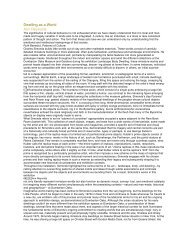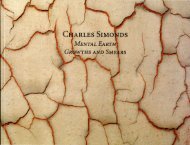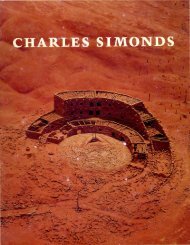The Lost Worlds of the 'Little People' - Charles Simonds
The Lost Worlds of the 'Little People' - Charles Simonds
The Lost Worlds of the 'Little People' - Charles Simonds
Create successful ePaper yourself
Turn your PDF publications into a flip-book with our unique Google optimized e-Paper software.
··<strong>The</strong> pieces arc a kind <strong>of</strong> gift to <strong>the</strong> street. Also a threat.<br />
But because <strong>the</strong>y are vulnerable, beautiful, precious. people<br />
respond to <strong>the</strong>m. <strong>The</strong>y identify with <strong>the</strong> labor that goes into<br />
<strong>the</strong>m, and that helps preserve <strong>the</strong>m. Children arc <strong>the</strong> main<br />
threat. and <strong>of</strong>ten <strong>the</strong> older children. <strong>the</strong> head honchos on <strong>the</strong><br />
block, will tell <strong>the</strong> smaller kids. "If you touch that I'm going<br />
to kick your tail. ...<br />
<strong>The</strong> length <strong>of</strong> time a street piece survives. <strong>Simonds</strong> says,<br />
depends on its height: ""<strong>The</strong> lower <strong>the</strong>y arc <strong>the</strong> more quickly<br />
<strong>the</strong>y will be destroyed by little children." <strong>Simonds</strong> doesn't<br />
announce when he will work on <strong>the</strong>m, nor does he invite<br />
critics to auend. and he doesn't come back to check on <strong>the</strong><br />
pieces· survival or destruction.<br />
T<br />
HE BASIC MATERIAL FOR ALL OF<br />
<strong>Simonds</strong>" work is clay. which he sprinkles with<br />
sand to give a patinu <strong>of</strong> age. an almost velvety<br />
texture. <strong>Simonds</strong> discusses clay in personalized terms.<br />
"Every clay is different.·· he says. "It responds differently<br />
when you touch it. If you arc aware. it speaks. It tells you<br />
who it is."<br />
<strong>Simonds</strong> has a favorite spot ncar Sayreville, New Jersey,<br />
for obtaining his clays. Once or twice a year he packs up a<br />
front-end loader scoopful or two and brings it back to his<br />
studio. Most <strong>of</strong> <strong>the</strong> clays he uses are not cleaned or<br />
homogenized. <strong>The</strong> clays can stay around for years: dry clays<br />
are easily revived with water.<br />
Some critics have schematized <strong>the</strong> meanings <strong>of</strong> <strong>Simonds</strong>"<br />
different clays into rigidity. In fact. he says. "<strong>The</strong> color <strong>of</strong><br />
88/ ARTNtWS<br />
<strong>the</strong> clay is important , but not programmatic . <strong>The</strong> red has a<br />
thousand moments. ll's extraordinary for its Ocshiness. ll's<br />
rubbery: it almost springs back when you touch it. For me,<br />
its association with <strong>the</strong> body is inescapable.<br />
"<strong>The</strong> gray suggests stone. blocks or rocks. From <strong>the</strong>se<br />
two basics it is easy to project a larger series <strong>of</strong> associations.<br />
It all has to do with how you use <strong>the</strong> clay. <strong>the</strong> history <strong>of</strong><br />
what you remember it having been."<br />
O<strong>the</strong>r colors seem to take <strong>the</strong>ir meanings for <strong>Simonds</strong><br />
from those two basics-red for <strong>the</strong> animated earth. gray for<br />
<strong>the</strong> buildings and o<strong>the</strong>r works <strong>of</strong> man. "I have a pink.'" he<br />
says. "that will make you blush. ll's bener than makeup.<br />
<strong>The</strong>re arc green clays-things you wouldn't imagine. ·•<br />
<strong>Simonds</strong> collects clays-and sands as well-from different<br />
parts <strong>of</strong> <strong>the</strong> world . Recent! y. for instance. a friend was<br />
delegated to bring back a new supply <strong>of</strong> yellow clay Sim·<br />
onds had found at a Berlin tile manufacturer's.<br />
He can speak <strong>of</strong> clay in affectionate, almost intimate<br />
terms because he has been working wirh it since he was very<br />
young. Along with his older bro<strong>the</strong>r, John. <strong>Simonds</strong> studied<br />
clay modeling with John De Marco and Claire Frezano.<br />
Italian sculptors in New York who did architectural<br />
sculpture-"angels on churches and so on:· he says.<br />
<strong>Simonds</strong> turned out to have a natural gift for making clay<br />
ponraits. ··<strong>The</strong>re was never much question as to what I was<br />
going to do in life. because working with clay was what I<br />
could do ... Even today, he says, "<strong>the</strong>re arc things I watch<br />
my hand do that are almost thoughtless. I can remember <strong>the</strong><br />
moment <strong>of</strong> learning <strong>the</strong>m. II is knowledge you have in <strong>the</strong>
so <strong>the</strong>re was no purpose in continuing. It's not as if you can<br />
fundamentally change things <strong>the</strong>re. You can only scratch<br />
<strong>the</strong> surface and that will always be true."<br />
<strong>Simonds</strong> has been fortunate up until now in having been<br />
able tO carry out his work without <strong>the</strong> services <strong>of</strong> a gallery.<br />
Almost since <strong>the</strong> beginning <strong>of</strong> his career he has had numerous<br />
commissions and grants from individuals, foundations<br />
and museums- including a D.A.A .D. grant from <strong>the</strong> German<br />
government and <strong>the</strong> grant from Artpark. He li ves<br />
sparely, devoting most <strong>of</strong> his time to work and travel. Last<br />
fall, however, he cast his lot with <strong>the</strong> Castelli Feigen Corcoran<br />
gallery, which now represents him.<br />
<strong>Simonds</strong> has also done a number <strong>of</strong> pieces for pri vate<br />
homes, including one for a collector in Antwerp, Belgium.<br />
·Tm interested in <strong>the</strong> point at which a home becomes part<br />
<strong>of</strong> conscious behavior, a reflection <strong>of</strong> <strong>the</strong> mind <strong>of</strong> <strong>the</strong><br />
owner, as opposed to being a simple shell or nest. " he says.<br />
<strong>Simonds</strong> contrasts his work for private patrons with that in<br />
<strong>the</strong> street. "When you work with a family you have to<br />
become very close to <strong>the</strong>m. unlike on <strong>the</strong> street. You are<br />
poking around, seeing what nerve you touch."<br />
A number <strong>of</strong> his ideas remain in <strong>the</strong> form <strong>of</strong> s ketches or<br />
models. (<strong>Simonds</strong> says that he is not a very good draftsman<br />
and resorts to sketches only when he is not in a position to<br />
execute a project immediately.) <strong>The</strong> floating city idea is one<br />
such project. <strong>Simonds</strong> says that it grew out <strong>of</strong> a proposal<br />
several years ago to build a floating park in <strong>the</strong> East Ri ver.<br />
" I thought , 'What if everybody could have a barge with his<br />
own fantasy landscape on it?' <strong>The</strong>n, later. I saw a newspaper<br />
article about floating factories. [<strong>The</strong> factory was one<br />
that billionaire industrialist Daniel Ludwig had built in Japan,<br />
<strong>the</strong>n floated to his wood pulp operations in Brazil.]!<br />
began to imagine all sorts <strong>of</strong> buildings migrating from plac.e<br />
to place on water."<br />
Part <strong>of</strong> <strong>Simonds</strong>' rejection <strong>of</strong> <strong>the</strong> standard gallery system<br />
was implicit in <strong>the</strong> trans ient nature <strong>of</strong> much <strong>of</strong> his work.<br />
<strong>Simonds</strong>' street works are doomed to ephemerali ty from <strong>the</strong><br />
start, and at one point <strong>the</strong>y constituted about 90 percent <strong>of</strong><br />
his output. He has said that he likes <strong>the</strong> idea <strong>of</strong> his work<br />
continuing to exist as "an oral tradition," much as <strong>the</strong><br />
continu ity <strong>of</strong> history and culture in an early society is oral.<br />
<strong>Simonds</strong> saves <strong>the</strong> clay and o<strong>the</strong>r materials from tempo·<br />
rary or o<strong>the</strong>rwise destroyed pieces and reuses it; <strong>the</strong> materials<br />
thus acquire a kind <strong>of</strong> history <strong>of</strong> <strong>the</strong>ir own. <strong>The</strong> 12<br />
pieces in <strong>the</strong> cycle Circles and Towers Crowing ( 1978) that<br />
<strong>Simonds</strong> executed for exhibition in Europe (at <strong>the</strong> Museum<br />
Ludwig in Cologne, <strong>the</strong> National Gallery in Berlin and <strong>the</strong><br />
Galerie Baudoin Lebon in Paris) were constructed <strong>of</strong> materials<br />
that had been used in his project at Documen)a 6 in<br />
Kassel in 1977.<br />
Although his pieces have <strong>the</strong> feel <strong>of</strong> archeological<br />
sites-<strong>the</strong> sense <strong>of</strong> real places. where real people li ved.<br />
inviting our latter-day interpretation-<strong>Simonds</strong> does not<br />
base <strong>the</strong>m on actual peoples or on archeological research.<br />
His dwellings and o<strong>the</strong>r structures are <strong>of</strong>fered as something<br />
like uni versal prototypes <strong>of</strong> primitive dwellings. <strong>The</strong> permanent<br />
pieces, for instance, include pyramids , labyri nths,<br />
observatories, s ignal towers, ritual ruins-in fact, all <strong>the</strong><br />
types <strong>of</strong> structures that reflect <strong>the</strong> beliefs and mores <strong>of</strong> a<br />
society. Often, as in <strong>the</strong> Circles tmd Towers Crowing series,<br />
<strong>the</strong> earth takes on femi nine forms, with towers and<br />
o<strong>the</strong>r constructions assuming phallic and masculine shapes.<br />
<strong>Simonds</strong>' sites encourage <strong>the</strong> amateur anthropologist in<br />
90/ A R TN EW S<br />
every viewer tO ponder <strong>the</strong> nature <strong>of</strong> <strong>the</strong> people who occupied<br />
<strong>the</strong>m. <strong>The</strong>re is a strong sense <strong>of</strong> narrative, <strong>of</strong> legend<br />
and history. about his work. But while one part <strong>of</strong> <strong>the</strong> "in·<br />
terpretation" <strong>of</strong> <strong>the</strong> pieces turns on <strong>the</strong> mythology constructed<br />
by viewers, ano<strong>the</strong>r turns on <strong>Simonds</strong>" own<br />
mythology, as expressed in "Three Peoples." This essay.<br />
published originally in Genoa in 1975 and reprinted in <strong>the</strong><br />
catalogue <strong>of</strong> <strong>the</strong> current exhibition, is <strong>the</strong> clearest expositi on<br />
<strong>of</strong> <strong>the</strong> complex logic that lies behind his pieces.<br />
<strong>The</strong> first people. <strong>the</strong> ·' people <strong>of</strong> <strong>the</strong> straight line," arc<br />
wanderers. <strong>Simonds</strong> wrote, who, when <strong>the</strong>y " moved from<br />
one dwelling to <strong>the</strong> next .. . left everything behind un·<br />
touched as a museum <strong>of</strong> persona.! effects ." <strong>The</strong> dwellings <strong>of</strong><br />
<strong>the</strong>se people grow in lines, like roads. and frequently cross<br />
over each o<strong>the</strong>r. "<strong>The</strong> pas t," for <strong>the</strong>m, "formed a tremendous<br />
net on which <strong>the</strong>ir lives traveled . . . . "<br />
<strong>The</strong> "circular people" develop <strong>the</strong>ir cities in a series <strong>of</strong><br />
concentric rings around a "womb/dome" that resembles a<br />
southwestern American Indian kiva, <strong>The</strong> annual cycle <strong>of</strong><br />
things is <strong>the</strong> basis <strong>of</strong> life among <strong>the</strong> ··circular people.'' and<br />
<strong>the</strong> workaday regularity <strong>of</strong> <strong>the</strong>ir li ves is broken only by <strong>the</strong><br />
orgylike ceremony that concludes (or begins) each annual<br />
cycle .<br />
<strong>The</strong> " people <strong>of</strong> <strong>the</strong> spiral." <strong>Simonds</strong> wrote, have as <strong>the</strong>ir<br />
goal " to achieve both <strong>the</strong> greatest possible height (<strong>of</strong> <strong>the</strong>ir<br />
dwell ings) and to predict <strong>the</strong> very moment <strong>of</strong> collapse, <strong>the</strong><br />
moment when <strong>the</strong> last <strong>of</strong> <strong>the</strong>ir resources would be cons umed<br />
and <strong>the</strong>ir death inevitable.' · <strong>The</strong>se people he relates to those<br />
depicted by Pieter Bruegel <strong>the</strong> Elder in <strong>the</strong> painting Tlte<br />
Tower <strong>of</strong> Babel.<br />
S<br />
!MONDS' LIBRARY-PILES OF BOOKS<br />
stacked in odd places around his studio-reveals his<br />
deep interest in biology, especially in <strong>the</strong> architecture<br />
<strong>of</strong> living creatures. <strong>The</strong> books, which <strong>Simonds</strong><br />
seems to be in <strong>the</strong> habit <strong>of</strong> showing to writers interested in<br />
his work, include Karl von Ro-isch 's famous works on <strong>the</strong><br />
habits <strong>of</strong> bees as well as his Aninwl Architecture: Edward<br />
0 . Wilson'sSociobiology; tex tbooks on evolution; volumes<br />
on Sex U ves <strong>of</strong> Animals Without Backbones and P(lftems in<br />
N(lfure: and even a paperback <strong>of</strong> Arthur Herzog's novel Tlte<br />
Swarm .<br />
His interest in natural forms. in evolution and life cycles<br />
might at first seem at odds with <strong>the</strong> built worlds <strong>of</strong> his<br />
"Little People,'' <strong>the</strong>ir villages and ruins. But <strong>Simonds</strong>'<br />
biological interest is a deep one. He is not especiall y interested<br />
in architecture. he says. at least not in "stylistic<br />
terms." But <strong>the</strong> shape <strong>of</strong> a hornet's nest, or <strong>the</strong> organization<br />
<strong>of</strong> colonies <strong>of</strong> single-celled organisms, he finds fascinating.<br />
<strong>Simonds</strong>' work is susceptible to all sorts <strong>of</strong> serious<br />
academic and sociological references. Notes tO critical<br />
pieces about him are studded with names like Claude<br />
Levi-Strauss. Karl Jung. Mircea Eliadc. Gaston Bachelard,<br />
ltalo Calvino and Samuel Beckett. But <strong>the</strong> fact that he<br />
seems more interested in science than phi losophy hints at<br />
<strong>the</strong> real nature <strong>of</strong> <strong>Simonds</strong>' art: Its success lies in its<br />
avoidance <strong>of</strong> portentousness, its keeping a sense <strong>of</strong> place as<br />
well as playfulness in <strong>the</strong> foreground.<br />
For all its levels <strong>of</strong> anthropology and psychology. it is an<br />
art that remains highly personal. Its myth is built around a<br />
dedication to a private fantasy , and its es<strong>the</strong>tic, like its<br />
subject, is that <strong>of</strong> <strong>the</strong> container-<strong>the</strong> shell <strong>of</strong> <strong>the</strong> adult<br />
around <strong>the</strong> imagination <strong>of</strong> <strong>the</strong> child. •












